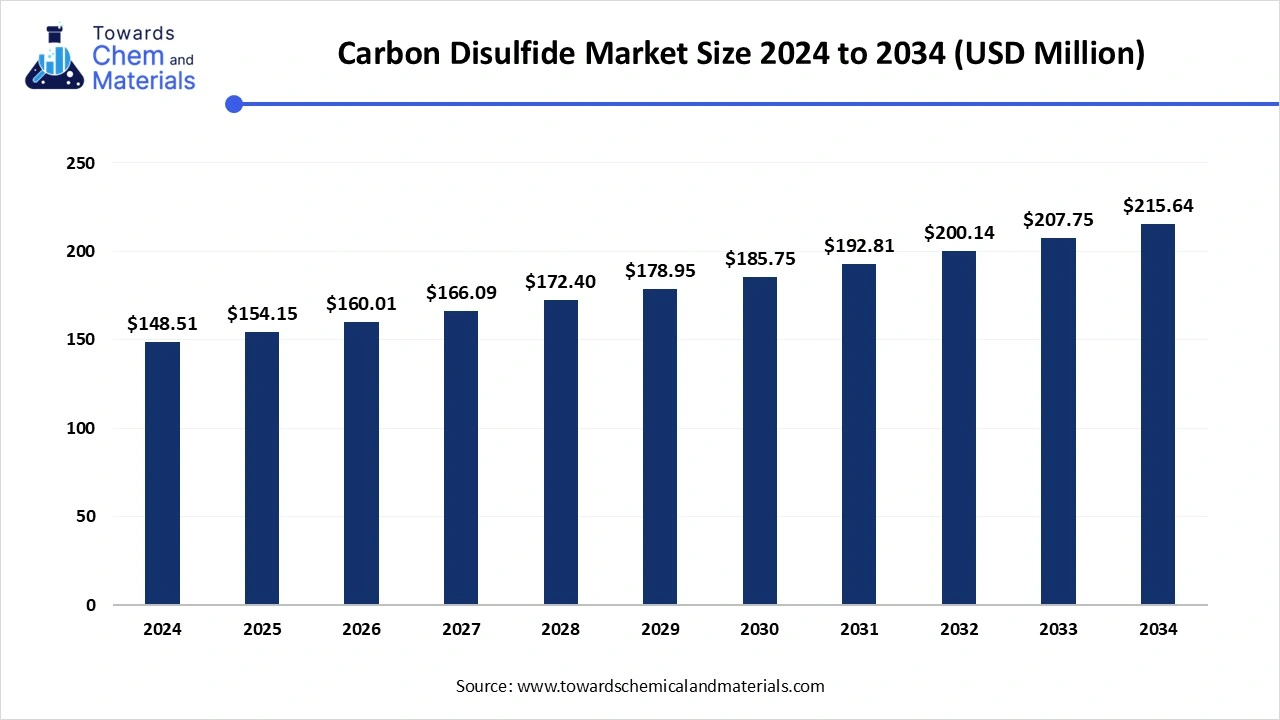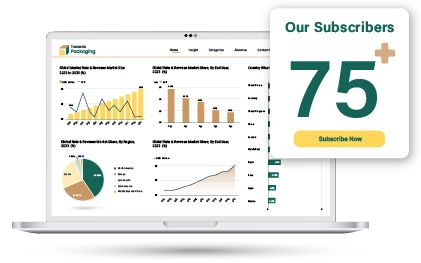Content
Carbon Disulfide Market Size and Growth 2025 to 2034
The global carbon disulfide market size was valued at USD 148.51 million in 2024 and is growing to approximately USD 215.64 million by 2034, with a developing compound annual growth rate (CAGR) of 3.8% over the forecast period 2025 to 2034. Growing demand from various industries and requirements for pest control and soil health management fuel the market growth.

Carbon Disulfide Market Key Takeaways:
- The Asia Pacific carbon disulfide market dominated the global market and accounted for the largest revenue share of 35.29% in 2024.
- The carbon disulfide market in China led the Asia Pacific market with the highest revenue share in 2024.
- North America carbon disulfide market held a substantial revenue share in 2024, driven by robust demand from the textile and agricultural industries.
- By purity, the pure segment led the carbon disulfide market in 2024.
- By purity, the impure segment is seen to grow at a notable rate during the predicted timeframe.
- By application, the rubber section dominated the carbon disulfide market in 2024.
- By end use, the agriculture segment dominated the global Carbon Disulfide industry and accounted for the largest revenue share of 14.55% in 2024.
- By end use, the packaging industry segment is expected to grow at a CAGR of 5.4% from 2025 to 2034.
Carbon Disulfide Market Overview
Carbon disulfide is a combination of carbon & sulphur at very high temperatures, and it is a clear colourless liquid. It is used as raw material in the production of viscose rayon, chemicals, pesticides, and cellophane. It has a pungent smell. The carbon disulfide market is classified into two types pure and impure. Carbon disulfide has wide applications such as rust removal from metal, petroleum well cleaning, solvent for components, and many more. The rising demand from various industries like agriculture, pharmaceuticals, textiles, chemicals, and packaging drives the growth of the market. Demand for cellulose-based products from textile and packaging industries needs carbon disulfide.
Carbon disulfide shaping the textile industry.
The rising consumer demand for sustainable and eco-friendly fabric increases the production of viscose rayon. Carbon disulfide is an important compound in the textile industry. To produce viscose solution carbon disulfide reacts with cellulose and caustic soda. Viscose rayon is used in various textile products such as fabrics, yarn, and tire cords. These fibers improve the material's softness, durability, and versatility. Carbon disulfide is a cost-effective alternative to expensive chemicals in the textile industry. Viscose rayon fiber has excellent moisture absorption quality, and it is biodegradable. carbon disulfide fibers easily combine with other fibers, and it has great colour absorption properties. The rising technological advancement in the textile industry drives the growth of the market.
Market Trends In Carbon Disulfide Market
- Rising sustainability awareness: The growing awareness about eco-friendly products leads to the adoption of sustainable production practices. Consumers are aware of environmental concerns that increase demand for carbon disulfide.
- Growing demand for rayon and cellophane: Rising demand for rayon and cellophane from the textile industry key factor for the market’s growth.
- Rising demand for bio-based alternatives: As the adoption of sustainability is growing there is a rising demand for bio-based alternatives in the textile and agriculture industry. This helps to reduce the use of harmful chemicals.
- Environmental regulations: Rising environmental rules and regulation helps manufacturers to innovate eco-friendly alternatives.
- Growing chemical industry: The growing usage of chemicals in agrochemicals and specialty chemicals increases demand for carbon disulfide.
- Booming industrialization: The growing industrialization in many countries demands higher production of carbon disulfide.
Carbon Disulfide Market Scope
| Report Coverage | Details |
| Market Size in 2025 | USD 154.15 Million |
| Expected Market Size in 2034 | USD 215.64 Million |
| Projected CAGR 2025 to 2034 | 3.80% |
| Dominant Region | Asia Pacific |
| Base Year | 2024 |
| Segments Covered | Application, region |
| Key Companies Profiled | Akzo Nobel N.V.; Merck KGaA; GFS Chemicals Inc.; PPG Industries, Inc.; Alfa Aesar; Univar Solutions Inc.; Jiangsu Jinshan Chemical Co. Ltd.; Arkema; Shikoku Chemicals Corporation; Zhuzhou Jinyuan Chemical Industry Co.,Ltd.; Shanghai Baijin Chemical Group Co., Ltd.; Jiaonian Ruixing Chemical; Tedia. |
Carbon Disulfide Market Opportunity
Growing adoption of sustainability choice
The rising consumer awareness about environmental issues demands sustainable choices. Carbon disulfide helps in numerous ways to promote sustainability. Carbon disulfide contributes to improving manufacturing processes to developing energy-efficient technologies. The textile industry is giving preference to sustainability and that demands environment-friendly choices. To produce viscous fiber carbon disulfide is used as raw material. Viscous is a renewable source and it is made up of wood pulp and other chemical ingredients. These environment-friendly choices help to reduce pollution, lower energy consumption and reduce waste. Carbon disulfide also helps in creating sustainable packaging solutions for products. Carbon disulfide helps lower carbon footprint and reduces greenhouse gas emissions. Growing adoption of sustainable choices in packaging, textiles, and many more industries will help in the rapid growth of the market.
Carbon Disulfide Market Challenge
Health risks due to exposure to carbon disulfide
With the several advantages of carbon disulfide in various industries, there are some health risks associated with carbon disulfide exposure. Health problems like neurological damage, cardiovascular issues, skin problems, and reproductive problems limit the usage of carbon disulfide. In females, menstrual disturbances have been noticed due to high exposure. Breathing in a carbon-disulfide environment for a long time affects the nervous system and causes changes in nerve functions. It causes various skin problems like irritation, redness, chemical burns, blistering, skin exfoliation, and pain. In several cases, coma, convulsions, and death can happen due to high exposure of carbon disulfide which is one of the leading factors that restrains growth of the market.
Carbon Disulfide Market Regional Insights
Asia Pacific is the powerhouse of carbon disulfide
Asia Pacific dominated the carbon disulfide market in 2024. The fastest-growing civilization and industrialization in the Asia Pacific countries like India, China, and Japan drive the growth of the market. The rising demand from textile, agriculture, and chemical industries fuels the growth of the carbon disulfide market. Additionally, the well-established agriculture sector in the region drives the need for soil sterilization, pest control, and soil fumigation fuels the growth of the market.
China holds the largest share of the carbon disulfide market in 2024. The rising industrialization in the country drives the growth of the market. The growing requirement for cellulose and cellulosic fiber from various industries fuels the growth of the market. Moreover, the agriculture industry in the region demands carbon disulfide for pest control, soil sterilization, soil fumigation, and seed treatment help to grow the market in the region.
North America exploring the growth of carbon disulfide
North America expects a significant growth in the market during the forecast period. The growing demand for carbon disulfide from textile and agricultural industries drives the growth of the market in the region. In the agriculture sector, carbon disulfide is widely used in seed treatment, pest control management, and soil sterilization. The growing demand for agrochemical production fuels the market growth. Furthermore, the production of cellulose-based material and rayon demands carbon disulfide because this market is growing rapidly.
The U.S. holds the largest share of the carbon disulfide market in the North American region. The rising demand from textiles and agriculture for rayon and other cellulose-based products propels the growth of the market in the region. Rapid innovation in the agricultural sector demands carbon disulfide. Furthermore, in the agricultural sector carbon disulfide is needed for soil fumigation and pest control fuels the growth of the market.
Carbon Disulfide Market Segmental Insights
By Purity
The pure segment dominated the carbon disulfide market in 2024. The market is growing due to high purity and less contamination. Industries are giving preference to precision and safety for solvent production and chemical synthesis increases demand for pure carbon disulfide. Whereas the impure segment expects a significant growth in the market during the forecast period. The rising demand from various industries like rubber manufacturing, mining, and pest control drives the growth of the market. The lower production cost and used applications that require high precision and safety drive the growth of the market.
By End Use
The agriculture segment dominated the carbon disulfide market in 2024. The need for pest control, crop protection, and soil fumigation drives the growth of the market. It is used in seed treatment and preventing the spreading of diseases. Carbon disulfide helps control in control the spread of fungi and nematodes and it improves the quality of soil. The chemical dithiocarbamates used in pest control are made from carbon disulfide. Whereas the packaging segment anticipated the significant growth in the market during the forecast period. The growing demand for cellophane, rayon, and other cellulosic fibers drives the growth of the market. This material provides flexibility, strength, and biodegradability of packaging materials. To develop sustainable and high-performance packaging, carbon disulfide is used in the chemical process. Additionally, consumer demand for eco-friendly sustainable packaging fuels the growth of the market.
By Application
The rubber section dominated the carbon disulfide market in 2024. In the process of vulcanization, carbon disulfide is used. It provides elasticity, durability, and strength to rubber. The rising demand for the automotive industry for rubber products drives the growth of the market. The growing requirement to produce tires and other automotive products fuels the growth of the market. Whereas the rayon is expecting a significant growth in the market during the forecast period. Rising production of viscose rayon in the textile industry drives the growth of the market. The increasing consumer preference for sustainable fabrics propels the growth of the market.
Carbon Disulfide Market Top Companies List
- GFS Chemicals Inc.
- Akzo Nobel N.V.
- PPG Industries, Inc.
- American Elements
- KANTO CHEMICAL CO., INC.
- Arkema
- Merck KGaA
- Alfa Aesar
- Tedia
- Jiaonian Ruixing Chemical
- Nouryon
- Liaonian Ruixing Chemical Group Co. Ltd.
- Perchem Fine & Specialty Chemicals
Recent Developments In Carbon Disulfide Market
- In January 2024, Birla Cellulose’s Kharach plant in Gujrat, India successfully deployed CAP (Carbon-disulphide Adsorption plant) CS2 for exhaust gases recovery system for achieving EU BAT status.
Carbon Disulfide Market Segments Covered
By Application
- Rubber
- Rayon
- Perfumes
- Cleaning Carbon Nanotubes
- Cellophane
- Others
By Purity
- Pure
- Impure
By End use
- Agriculture
- Pharmaceuticals
- Packaging
- Textile
- Cosmetics
- Other
By Geography
- North America
- Asia Pacific
- Europe
- Latin America
- Middle East & Africa
- Report Covered: [Revenue + Volume]
- Historical Year: 2021-2023
- Base Year: 2024
- Estimated Years: 2025-2034
